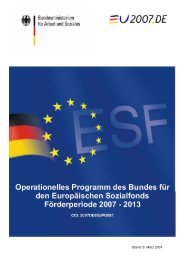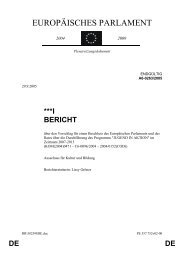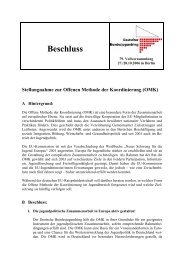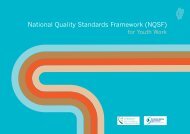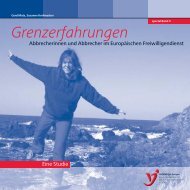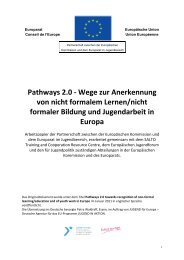Report - Salto
Report - Salto
Report - Salto
You also want an ePaper? Increase the reach of your titles
YUMPU automatically turns print PDFs into web optimized ePapers that Google loves.
Bridges for Recognition | Good Practice workshops - Overview and highlights<br />
51<br />
workshops<br />
o<br />
A significant part of the programme of Bridges was used to share good practice in Recognition<br />
from across the whole of Europe. In all there were 16 workshops and delegates were able attend<br />
four. Some examples were of well established work and others were “work in progress”. Some<br />
were country specific and others were Pan-European.<br />
The target groups for recognition include young people looking for jobs; disadvantaged young<br />
people and those from minority groups; youth workers and youth leaders and youth trainers.<br />
Most, if not all of the examples shown were voluntary schemes in that there was no compulsion<br />
to participate. In one case there was a right by law to have non-formal learning validated. Whilst<br />
the idea of recognition was universally seen as a personal outcome, the process could be carried<br />
out individually or in a group setting.<br />
Support for learners was seen as fundamental to the process of recognition and was discussed<br />
many times – whether the role was that of tutor, facilitator, mentor, counsellor, or assessor. The<br />
concept of peer support –learners working with each other and providing feedback - was also<br />
mentioned in at least one case.<br />
A common theme was the opportunity to integrate with and compliment the recognition<br />
processes of the formal education sector. There was an obvious commitment to the holistic<br />
development of young people and so the connections between formal, non-formal and informal<br />
education were highlighted in several workshops.<br />
The benefits of recognition were varied: Employability was cited in several cases as the main<br />
motivating factor, whilst for others there was the desire to help young people develop a positive<br />
vision of their lives. For youth workers, recognition processes provided and opportunity to<br />
describe and assess the work they and their young people were doing; for some, recognition<br />
was merely a tool of communication, enabling others to see the value of their work. At least<br />
one example had grown out of the desire to properly evaluate the benefits of a particular type<br />
of project.



